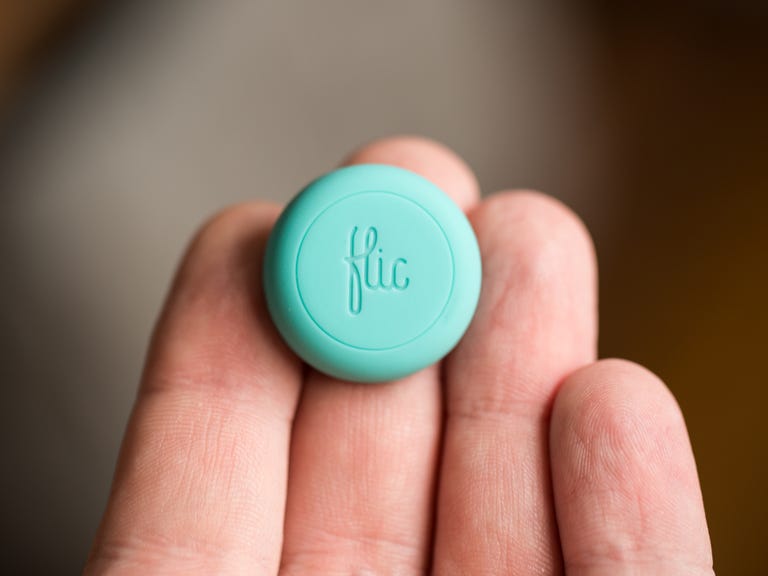 Why You Can Trust CNET
Why You Can Trust CNET Shortcut Labs Flic review: Coolest new tech: A $34 Flic smart button
Shortcut Labs' new smart button boasts the right partnerships to make it surprisingly useful in a connected home.
If you had a button that could do anything, what would you make it do? In my ideal smart home, that button would simplify otherwise complicated automation: press it once, turn off the lights; press it twice, turn on my game console; hold it down, order a pizza. And as it turns out, Flic, a smart button from Sweden-based Shortcut Labs, does exactly that and more.
The Good
The Bad
The Bottom Line
Flic started as an Indiegogo darling in 2014, and received over eight times its funding target (nearly a million dollars). Now it's making its way into the wide world of smart stuff, priced at $34 (about £24 and AU$47) per button or $99 (about £70 and AU$147) for four. The concept is simple: take a Bluetooth-enabled button, put it anywhere you want, and connect it to every app and device you can imagine. And it works, for the most part. Flic is a great product, especially for Android users and UK residents, and it looks like it will only keep getting better with each new partnership it adds.
An integration device like Flic is all about the partnerships. Shortcut Labs has partnered with Spotify, Logitech, Philips Hue, LIFX, Unified Remote, WeMo, Sonos, Zapier, IFTTT and even Domino's. Yes, that means you can order a pizza with the press of a button -- if you live in the UK. Users in the US will have to wait for that feature to cross the Atlantic.
The big question is this: Should you buy Flic? And the answer is, probably. It's relatively cheap -- if you get the four-pack, it's about $25 (£18 or AU$35) each -- and the button has something for everyone. That said, Android devices have around 50 Flic functions at present, as opposed to 27 functions on iOS devices. And UK users will get that awesome pizza-button function, whereas US and Australian users will have to wait for that. So some people definitely get a more flexible product out of the box than others.
But even living in the US with an iPhone, I can think of plenty of use cases for these Flic buttons. I can't cover everything these little gadgets do. Instead, here are a few ideas I had, and how they worked out:
In the home
I put Flic on the inside of the CNET Smart Home's front door. With one press, I can turn all the lights in the house on or off. With two presses, I can make my phone sound in case I can't find it. I would add the Domino's function if it were live in the US right now, but it isn't. This is one feature that I'd like to see debut as soon as possible.
In the car
I put Flic in my car to control phone communication in a safer way. With one press, I can send a text to my significant other that I'm on my way home. With two presses, I can call her. And with a long hold, I can have her response read aloud by my phone. All of these are easily accomplished on an Android phone, but iOS couldn't read the texts aloud, and required some workarounds using IFTTT to accomplish the other two. Despite those problems, the phone control in the car (perhaps in tandem with a second Flic to control my phone's music while driving) is one of the most useful I've found thus far.
On the go
Flic buttons come with clips that allow you to attach them to your clothes or a backpack. So I tested out Flic as a safety device, imagining how a kid or elderly adult -- or even just a student who has to cross campus alone at night -- would use it. With one click, I can call a friend. A double click automatically sends my location to a few select contacts. And a long hold sets off an alarm on my phone. I liked these features, but ran into some performance problems. The location-sending feature only worked consistently with my Android device, and it sent the location using a Google Maps URL that was always split between two text messages, making it impossible to just open by tapping. Right now, I wouldn't trust Flic enough to use it as a safety device.
Current problems and future solutions
Flic isn't a perfect product at this point. Because the buttons work on Bluetooth with your phone, users have to always carry their mobile devices with them. Additionally, the iOS version of the app is much less developed than the Android version. In fact, the app must be running in the background on iOS devices for Flic to work. Finally, features that would really make Flic stand out aren't quite here yet. Yes, in the UK you can order Domino's. But I want to see Flic partner with more food services, and bring those partnerships to the United States, Australia and other countries.
Even accounting for all those problems, Flic has undeniably high potential, just by merit of its flexibility and affordability. I'm excited to see these smart buttons continue to get smarter.


